How to find the right grind for your coffee machine Part 1 How to adjust and why.
What is the right size grind for a coffee machine?
This is the first of a two part series on helping you find the right grind. It covers the grinders functions and how to adjust them. It will also help you understand the correlation between espresso and the ground coffee particle size.
NOTE: It’s important to read through both part 1. & part 2. before you attempt to adjust your grinder. If your grinder is new, ensure you read our post – How to adjust a new grinder – Step-by-step guide. Especially if you’ve never used a grinder before.
One of the biggest contributing factors towards the flavour of your espresso coffee is the grind texture.
I am often asked “What is the right size grind for a coffee machine? The reality is, that it’s quite simple. All it takes is a small adjustment and your coffee tastes great.
However, to know how, when and which way to adjust your grinder you must firstly understand the principles behind Espresso and the Grinder. You’ll also need to know what constitutes a good espresso coffee.
So, then you’ll know how to get the right size grind setting for espresso. And, as you’ll learn, there’s no magic number setting for all grinders. That’s why you’re here.
So let’s get grinding.
Principle behind espresso making.
A true Espresso coffee has a persistent golden mahogany coloured ‘Crema’ floating on top of the coffee.

Perfect espresso
Firstly I’d like pay homage to Italy for the invention of the Espresso Coffee. A love that has come to be appreciated by all coffee lovers throughout the world. Congratulations!
Definition of espresso.
Espresso as we all know it, is a strong concentrated coffee served in a small cup created when ground coffee meets pressurized hot water.
As a result a mahogany/honey coloured layer of foam called the ‘Crema’ floats on the top. It’s made by a Barista and prepared fresh on demand through an espresso coffee machine.
The coffee machine preheats the water (90-97 deg. C) and forces it under pressure (9 bar) for 25-30 sec’s onto the ground coffee (7-9 g) and extracts a volume of 25-30 ml of freshly brewed espresso coffee. Bellissimo!
Note: The ground coffee is firmly packed in a stainless steel filter basket (porta filter). During the extraction, the ground coffee does not swirl or move under the pressurized hot water. The pressurized hot water slowly moistens the ground coffee as it extracts the flavour. In addition, the brewing water temperature and pressure remain fairly constant.
So, the variables we have left to control our coffee extraction rate, is the grind texture particle and the ground coffee dose.
Principle behind grinding coffee.
Grinding coffee is the process by breaking up the coffee bean size into defined finer particles.
How good is it to wake up and smell the Aroma of freshly ground coffee.
All coffee grinders don’t look the same but luckily they all operate in the same way. That is to grind coffee.
First up, let’s open the grinders mouth and have a look at the teeth. Picture a ceiling fan and instead of those blades which look like propellers, picture two flat circular grinding discs with beveled teeth known as burrs.
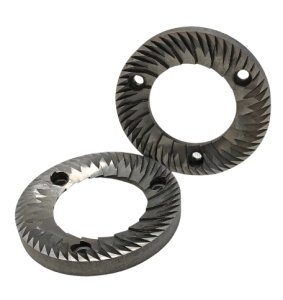
Flat burr disc blades
Now what happens during the grinding process. The coffee beans fall into the grinding discs via gravity. From there they travel in between the grinding discs via the rotation of one of the discs.
The burrs are machined in a specific directional pattern as to allow the coffee to flow through the blades. Hence, preventing the overgrinding and heating of the coffee. As the coffee is being ground it centrifugally falls into the outlet chute ready to be brewed.
By having these grooved discs equal distance apart the grind texture is more controlled. Hence, a more uniform (particle size) grind texture is achieved.
What this means is that the burrs are actually crushing/cutting the coffee beans to a preset particle size.
Simplified, Think of the distance between the blades as a gap.
A coarser grind has a larger gap between the two blades. And a finer grind has a smaller gap between the two blades.
Unfortunately the brittle nature of the roasted coffee beans and the aggressiveness of the grinding process will always produce some particle sizes either side of our desired (set) target size.
As the grinding discs start to wear, this becomes more prominent.
There are two main types of grinding blades, flat discs and conical. The conical blades work in the same way as the disc blades. The only difference is that
they’re cone shaped and rotate at lower revolutions.
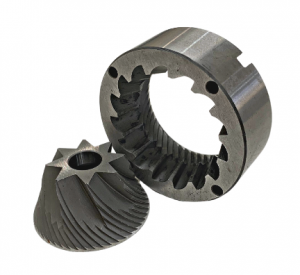
Conical grinding blades
In addition, but less popular there’s also a very small grinder that looks like a drink blender, the good old fashioned ‘spice mill’. It’s blades are very similar to a propeller. I would recommend to avoid using this type of grinder because there’s no grind texture setting. It works on randomly smashing the beans within the canister and as a result the particle size distribution is extremely irregular.
What role does the correct grind size texture play in espresso.
In order to find the right size grind for your coffee machine, you need to understand the role of the ground coffee particle size.
Grind texture offers resistance against the pressurized hot water, hence determines the extraction flow rate of your espresso.
As mentioned earlier on, the grind particle size is the biggest contributing factor towards the coffees flavour.
Did you know that 9 bar of pressure is used to extract an espresso and is almost equivalent to 3 times the pressure in car tyres.
So, the importance of the correct size grind setting for espresso is to slow down (offer resistance) and control the coffee extraction rate for optimum flavour. This is achieved by adjusting your grind setting either finer or coarser. The rate of extraction will determine which way you need to adjust your grinder.
Refer to standard espresso extraction parameters in part 2 how to find the right grind for your coffee machine.
Earlier on we touched on the grind texture particle size and the ground coffee dose. These are the two remaining variables that allows us to control the extraction time. To simplify the grinder adjustment, we need to only work with one variable. Hence, you MUST ensure that you keep your ground coffee dose constant.
Tamping the coffee
It’s important to always evenly tamp your coffee with constant pressure. This allows the hot water to evenly moisten the coffee as it extracts all the flavour.
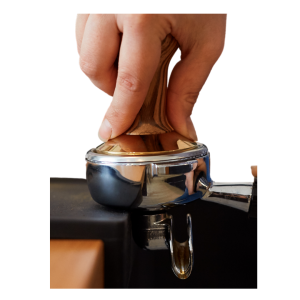
In addition, a firmly packed coffee cake provides even resistance against the hot water.
If the coffee cake is unevenly packed or isn’t firmly packed there’s a good chance of channeling occurring. What this means is that the hot pressurized water will find the weakest point first (an area offering less resistance) and penetrate through it.
This results in an uneven distribution of flavour and a flat tasting coffee. You’ll notice the crema seems a little different in colour. It’s quite tricky to detect during the extraction, but it’s visible when you remove the handle from the coffee machine and look at the moisten coffee grounds. You’ll notice small indented holes in the spent coffee grains.
Ground coffee dose
Once you’ve tamped your coffee, the levelled ground coffee dose should sit a couple of millimeters below the indentation on the portafilter basket. This dose will give you approximately 9-10 gms for a single and 17-18 gms in a double portafilter. However, this will depend on the size of your portafilters.
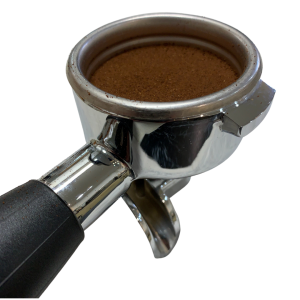
Ground Coffee Dose
Don’t be too concerned, just ensure each time that you keep the same distance below the portafilter indentation.
You can weigh the ground coffee dose if you prefer. However, you’ll be surprised how accurately you can visually and constantly load the ground coffee dose. This is the way I prefer to see people making coffee. It’s shows me that they’ve grasped the concept, and are skillfully making coffee. Perfetto!
“If you don’t keep the ground coffee dose constant, you will end up going round in circles and become extremely frustrated.”
Let’s look at ground coffee particle size.
A finer grind setting slows down the extraction flow rate. A coarser adjustment speeds up the extraction flow rate.
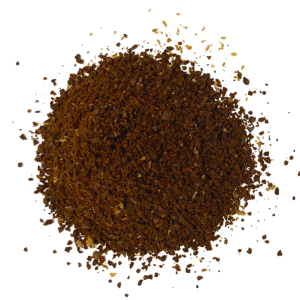
Very Coarse Grind
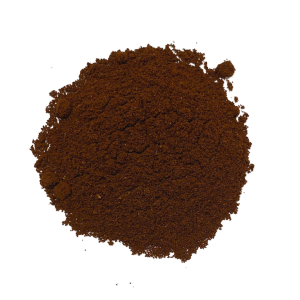
Fine Espresso Grind
Coarsely ground coffee has larger particles than finely ground coffee. As a result, there’s larger air spaces between the coarser particles than the finer particles. Hence, water travelling at the same pressure will pass quicker through coarser particles.
What this means it that the coarser particles offer less resistance than finer particles. So, if you need to slow down you flow rate, then you need to adjust the grind setting in the finer direction. Alternatively if you need to increase your flow rate, then you need to adjust your grinder in the coarser direction.
Grinder adjustment – Getting the right size grind for a coffee machine.
Getting the crema right is a good visual indication in helping you nail the grind.

Perfect Espresso flow
Espresso just isn’t espresso without the crema.
The crema will vary in consistency with various grinds. If your grind texture is too coarse the crema will be thin and dissipate quickly.
In addition the espresso flavour will be flat and under extracted.
If your grind texture is too fine, the crema will seem Ok but will have a paler circular area on it. This will result in a bitter over extracted coffee.
Adjusting wheel/knob
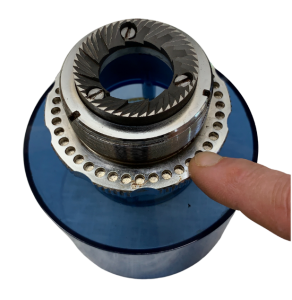
Stepped Adjusting Wheel
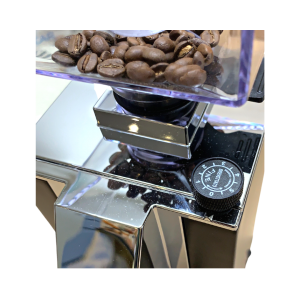
Infinite adjusting knob
Today there’s a huge range of grinders on the market available for home or commercial use. They either have a stepped or an infinite adjusting collar/wheel/knob.
The stepped adjusting wheel has preset grinding intervals. Whereas the infinite adjusting wheel is limitless and offers more accuracy.
Once you get the right size grind, you’ll then appreciate that the infinite adjustment is the way to go.
Which way is finer
Note: Varying brands can have opposite directional adjustment threads. What this means is that one brand of grinder may have a clockwise direction for it’s coarse setting and another brand may have the clockwise direction as it’s finer setting.
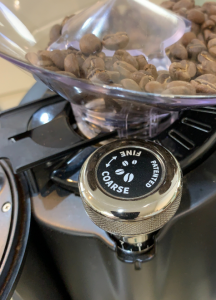
Clockwise Finer
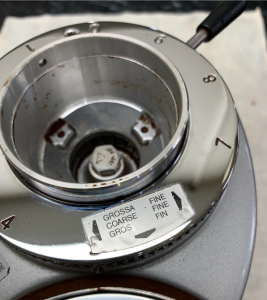
Clockwise Coarser
Ensure you look at the labelling direction of the adjusting wheel/knob before attempting to make any adjustments.
Grasp the understanding of the adjusting direction especially if you’re a beginner.
Why do you need to adjust your grinder
The sole purpose of adjusting your grinder is to improve the
flavour of your espresso.
Does your coffee taste watery, flat or bitter? Then let’s fix it. It’ll only take a few seconds.
There’s many reasons as to why you need to adjust your grinder, and they all relate back to taste.
A few of the main reasons are:-
- Thin pale coloured crema.
- The coffee lacks body.
- Extraction time very short. (below 18 sec’s)
- Extraction time too long. (over 40 sec’s)
- Different pack of coffee beans.
- Humidity.
- Coffee beans are too fresh.
- Coffee is starting to stale.
By now your probably thinking this is all too much, why did I buy a grinder. Don’t worry, hang in there and once you have a few attempts you’ll grasp the concept.
From there on you’ll know when and how to adjust your grinder. It’ll only take you a few seconds – guaranteed. I’ve trained hundreds of people over the years and once they get it, they don’t forget it.
It’s amazing to see people learning espresso extraction for their first time. What impresses me is how quickly they can visually understand if the coffee flow is acceptable or not. You too can do this. It’s a matter of building confidence and this can only come by having a go. Just do it, you’ll be fine.
Since the grind texture particle size will affect the extraction time, then your grind adjustment is the most important function that will allow you to make espresso coffee within the parameters. So, start adjusting here.
End of part 1.
Well done, you’re half way there.
We’ve now covered the principles of espresso and the grinder, the relationship between espresso and the ground coffee particle size. We also covered the functions of the grinder and how to adjust it. We defined an espresso and explained the importance of keeping all variables constant such as the tamping and the ground coffee dose.
So, by now you should have a fairly good idea of why you need to adjust your grinder and what happens to the coffee when you do.
If you are experienced with using a grinder you may now want to attempt to find the right size grind for your coffee machine. However, I suggest you also read, How to find the right grind for your coffee machine part 2. In our second post we cover real scenarios and problems to avoid.
Continue reading part 2.
Copyright Mocha Coffee Pty Ltd 2021
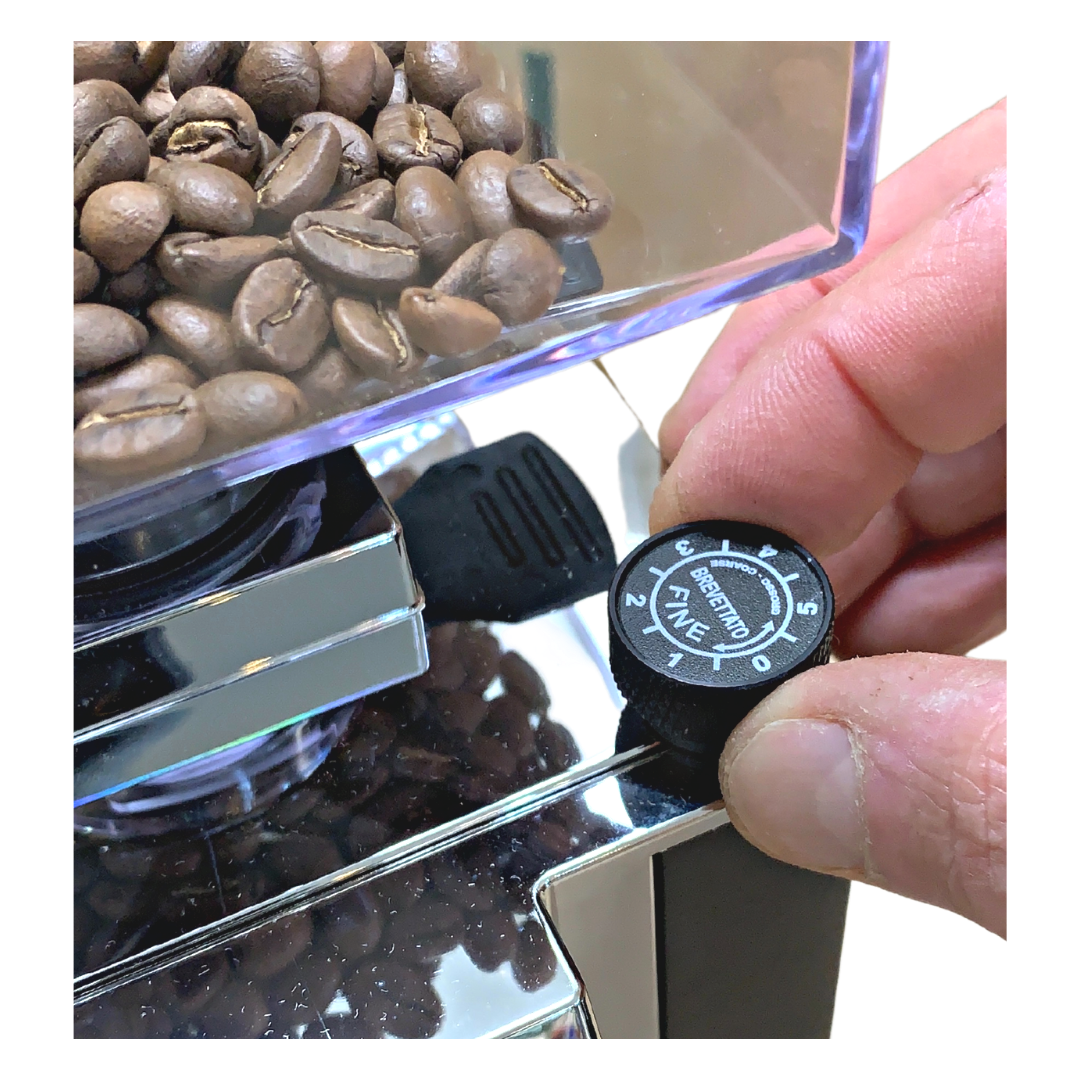
















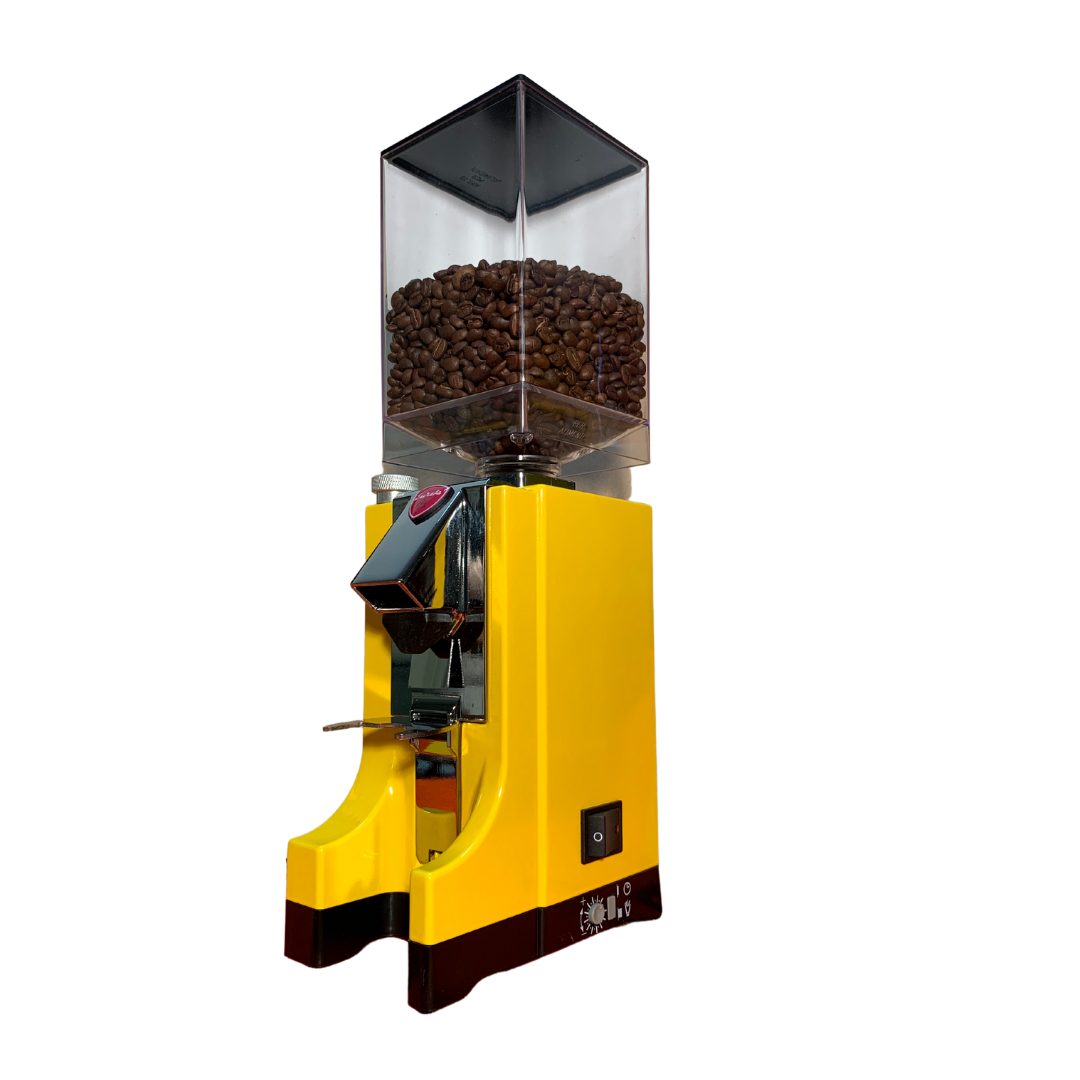
Vincent
September 22, 20213:12 amExcellent information thanks Paul !
Paul Mannassis
September 23, 20212:38 amThat’s great to hear. Thanks for your feedback Vincent.
Guy Vaillant
August 19, 202210:30 amPerfect information for a novice like me to get some technical pre-knowlege before getting into the practical.
Paul Mannassis
August 20, 202211:53 pmIt’s good to hear that you found our blog very informative. I hope it helps you nail the grind and enjoy a lifetime of making great espressi.